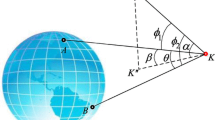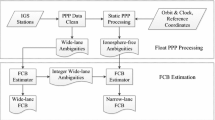Abstract
Precise point positioning (PPP) integer ambiguity resolution is able to significantly improve the positioning accuracy with the correction of fractional cycle biases (FCBs) by shortening the time to first fix (TTFF) of ambiguities. When satellite orbit products are adopted to estimate the satellite FCB corrections, the narrow-lane (NL) FCB corrections will be contaminated by the orbit’s line-of-sight (LOS) errors which subsequently affect ambiguity resolution (AR) performance, as well as positioning accuracy. To effectively separate orbit errors from satellite FCBs, we propose a cascaded orbit error separation (COES) method for the PPP implementation. Instead of using only one direction-independent component in previous studies, the satellite NL improved FCB corrections are modeled by one direction-independent component and three directional-dependent components per satellite in this study. More specifically, the direction-independent component assimilates actual FCBs, whereas the directional-dependent components are used to assimilate the orbit errors. To evaluate the performance of the proposed method, GPS measurements from a regional and a global network are processed with the IGSReal-time service (RTS), IGS rapid (IGR) products and predicted orbits with \(>\)10 cm 3D root mean square (RMS) error. The improvements by the proposed FCB estimation method are validated in terms of ambiguity fractions after applying FCB corrections and positioning accuracy. The numerical results confirm that the obtained FCBs using the proposed method outperform those by conventional method. The RMS of ambiguity fractions after applying FCB corrections is reduced by 13.2 %. The position RMSs in north, east and up directions are reduced by 30.0, 32.0 and 22.0 % on average.










Similar content being viewed by others
References
BKG (2013) BKG Ntrip Client (BNC) Version 2.8 manual. Federal Agency for Cartography and Geodesy, Frankfurt
Collins P (2008) Isolating and estimating un-differenced GPS integer ambiguities. In: Proceedings of ION national technical meeting. San Diego, pp 720–732
Dousa J (2010) The impact of errors in predicted GPS orbits on zenith troposphere delay estimation. GPS Solut 14:229–239
Gabor MJ, Nerem RS (1999) GPS carrier phase ambiguity resolution using satellite-satellite single difference. In: Proceedings of ION GNSS 12th International Technical Meeting of the Satellite Division. Nashville, pp 1569–1578
Ge M, Gendt G, Rothacher M, Shi C, Liu J (2008) Resolution of GPS carrier-phase ambiguities in precise point positioning (PPP) with daily observations. J Geod 82(7):389–399
Geng J, Meng X, Dodson AH, Ge M, Teferle FN (2010) Rapid re-convergences to ambiguity-fixed solutions in precise point positioning. J Geod 84:705–714
Gendt G, Dick G, Reigber CH, Tomassini M, Liu Y, Ramatschi M (2003) Demonstration of NRT GPS water vapor monitoring for numerical weather prediction in Germany. J Meteorol Soc Jpn 82(1B):360–370
Hadas T, Bosy J (2015) IGS RTS precise orbits and clocks verification and quality degradation over time. GPS Solut 19(1):93–105
Hatch R (1982) The synergism of GPS code and carrier measurements. In: Proc. the third international symposium on satellite Doppler positioning at Physical Sciences Laboratory of New Mexico State University, vol. 2, pp 1213–1231
Hauschild A, Montenbruck O (2009) Kalman-filter-based GPS clock estimation for near real-time positioning. GPS Solut 13:173–182
Kouba J (2009) A guide to using international GNSS service (IGS) products. http://igscb.jpl.nasa.gov/components/usage.html
Laurichesse D, Mercier F, Berthias J, Broca P, Cerri L (2009) Integer ambiguity resolution on undifferenced GPS phase measurements and its application to PPP and satellite precise orbit determination. Navigation 56(2):135–149
Li Y, Gao Y, Shi J (2014a) Real-time PPP Ambiguity resolution with satellite FCBs estimated considering obit errors. In: Proceedings of ION GNSS+ 2014. Tampa, pp 1008–1019
Li Y, Gao Y, Li B (2015a) An impact analysis of arc length on orbit prediction and clock estimation for PPP ambiguity resolution. GPS Solut 19(2):201–213
Li X, Zhang X (2012) Improving the estimation of uncalibrated fractional phase offsets for PPP ambiguity resolution. J Navig 65:513–529
Li X, Ge M, Dousa J, Wickert J (2014b) Real-time precise point positioning regional augmentation for large GPS reference networks. GPS Solut 18(1):61–71
Li X, Ge M, Dai X, Ren X, Fritsche M, Wickert J, Schuh H (2015b) Accuracy and reliability of multi-GNSS real-time precise positioning: GPS, GLONASS, BeiDou, and Galileo. J Geod 89(6):607–635
Melbourne W (1985) The case for ranging in GPS-based geodetic systems. In: First international symposium on precise positioning with the global positioning system. Rockville, pp 373–386
Montenbruck O, Steigenberger P, Hauschild A (2015) Broadcast versus precise ephemerides: a multi-GNSS perspective. GPS Solut 19(2):321–333
Petit G, Luzum B (2010) Frankfurt am Main: Verlag des Bundesamts für Kartographie und Geodäsie
Shi J, Gao Y (2014) A comparison of three PPP integer ambiguity resolution methods, GPS Solut 18(4):519–528
Schmid R, Steigenberger P, Gendt G, Ge M, Rothacher M (2007) Generation of a consistent absolute phase-center correction model for GPS receiver and satellite antennas. J Geod 81(12):781–798
Teunissen PJG, Odijk D, Zhang B (2010) PPP-RTK: results of CORS network-based PPP with integer ambiguity resolution. J Aeronaut Astronaut Aviat Ser A 42(4):223–230
Teunissen PJG, Khodabandeh A (2015) Review and principles of PPPRTK methods. J Geod 89(3):217–240
Wang M (2014) Ambiguity Resolution with Precise Point Positioning, Ph.D. Thesis, Department of Geomatics Engineering, University of Calgary. http://hdl.handle.net/11023/1586
Wu JT, Wu SC, Hajj GA, Bertiger WI, Lichten SM (1993) Effects of antenna orientation on GPS carrier phase. Manuscr Geod 18(2):91–98
Wübbena G (1985) Software developments for geodetic positioning with GPS using TI-4100 code and carrier measurements. In: First international symposium on precise positioning with the global positioning system. Rockville, pp 403–412
Zhang X, Li P (2013) Assessment of correct fixing rate for precise point positioning ambiguity resolution on a global scale, GPS Solut 87(6):579–589
Acknowledgments
The author is supported by Chinese Scholarship Council (CSC), Natural Sciences and Engineering Research Council of Canada (NSERC), Alberta Innovates Technology Futures (AITF) and National Natural Science Foundation of China (Grant No. 41504027), which are all acknowledged. The GPS data sets collected from IGS network were used in this study, which is acknowledged.
Author information
Authors and Affiliations
Corresponding author
Rights and permissions
About this article
Cite this article
Li, Y., Gao, Y. & Shi, J. Improved PPP ambiguity resolution by COES FCB estimation. J Geod 90, 437–450 (2016). https://doi.org/10.1007/s00190-016-0885-x
Received:
Accepted:
Published:
Issue Date:
DOI: https://doi.org/10.1007/s00190-016-0885-x




